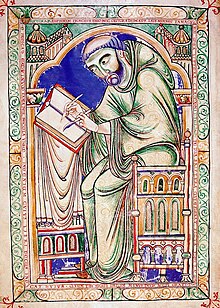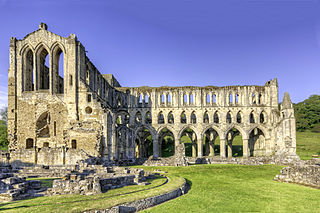
Rievaulx Abbey was a Cistercian abbey in Rievaulx, near Helmsley, in the North York Moors National Park, North Yorkshire, England. It was one of the great abbeys in England until it was seized in 1538 under Henry VIII during the Dissolution of the Monasteries. The wider site was awarded Scheduled Ancient Monument status in 1915 and the abbey was brought into the care of the then Ministry of Works in 1917. The ruins of its main buildings are today a tourist attraction, owned and maintained by English Heritage.

Chrétien de Troyes was a French poet and trouvère known for his writing on Arthurian subjects such as Gawain, Lancelot, Perceval and the Holy Grail. Chrétien's chivalric romances, including Erec and Enide, Lancelot, Perceval and Yvain, represent some of the best-regarded works of medieval literature. His use of structure, particularly in Yvain, has been seen as a step towards the modern novel.

Marie of France was a Capetian princess who became Countess of Champagne by her marriage to Henry I of Champagne. She served as regent of the County of Champagne three times: during Henry I's absence from 1179-1181; during the minority of their son Henry II from 1181–1187; and during Henry II's absence from 1190-1197. The daughter of Eleanor of Aquitaine and Louis VII of France, she was the sister of Alice of France and the half-sister of: William IX, Henry the Young King, Richard I, Geoffrey of Brittany, Matilda of England, Eleanor of England, Joan of England, John of England; Margaret of France, Alys of France, Agnes of France, Philip II of France; and the stepdaughter of Henry II of England, and Constance of Castile, and Adela of Champagne.
Benedict, sometimes known as Benedictus Abbas, was abbot of Peterborough. His name was formerly erroneously associated with the Gesta Henrici Regis Secundi and Gesta Regis Ricardi, English 12th-century chronicles, which are now attributed to Roger of Howden.
This article contains information about the literary events and publications of the 13th century.
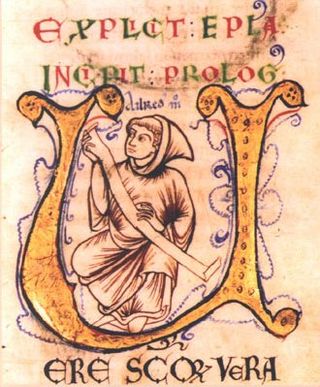
Aelred of Rievaulx, O Cist., also known as also Ailred, Ælred, or Æthelred; was an English Cistercian monk and writer who served as Abbot of Rievaulx from 1147 until his death. He is venerated by the Catholic Church as a saint and by some Anglicans.
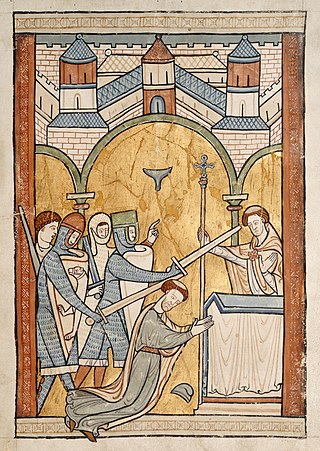
William Fitzstephen, was a cleric and administrator in the service of Thomas Becket. In the 1170s he wrote a long biography of Thomas Becket – the Vita Sancti Thomae.

Chronicon Lethrense is a small Danish medieval work from the late 12th century, written in Latin.

Reginald of Durham was a Benedictine monk and hagiologist, a member of the Durham Priory and associated with Coldingham Priory in Scotland.
John of Hexham was an English chronicler, known to us merely as the author of a work called the Historia XXV. annorum, which continues the Historia regum attributed to Symeon of Durham, and contains an account of English events from 1130 to 1153.

Medieval French literature is, for the purpose of this article, Medieval literature written in Oïl languages during the period from the eleventh century to the end of the fifteenth century.
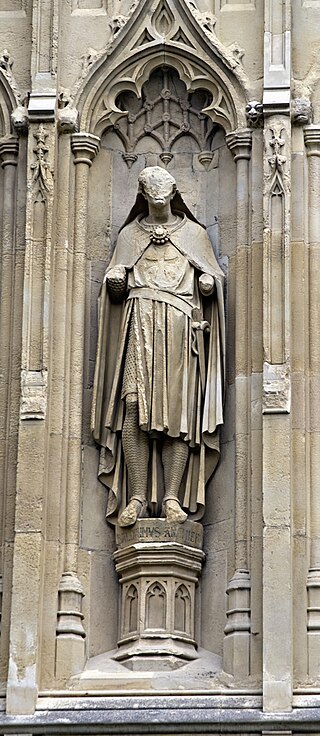
Baldwin of Forde or Ford was Archbishop of Canterbury between 1185 and 1190. The son of a clergyman, he studied canon law and theology at Bologna and was tutor to Pope Eugene III's nephew before returning to England to serve successive bishops of Exeter. After becoming a Cistercian monk he was named abbot of his monastery at Forde and subsequently elected to the episcopate at Worcester. Before becoming a bishop, he wrote theological works and sermons, some of which have survived.
This article presents lists of the literary events and publications in the 11th century.
Events from the 1160s in England.
Events from the 1110s in England.
Ælfgifu of York was the first wife of Æthelred the Unready, King of the English; as such, she was Queen of the English from their marriage in the 980s until her death in 1002. They had many children together, including Edmund Ironside. It is most probable that Ælfgifu was a daughter of Thored, Earl of southern Northumbria and his wife, Hilda.

Akhsitan I was the 20th Shirvanshah after 1160, and thought to have reigned until the years 1197–1203/04. He was the son and successor of Manuchihr III. His mother was Tamar, a Georgian princess from the Bagrationi dynasty.
